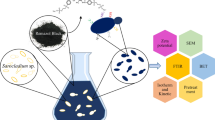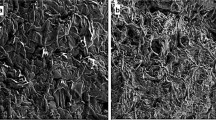Abstract
In this study, Earliella scabrosa naturally available medicinal fungus has been introduced for the removal of Bromocresol green from aqueous solution. This fungus can also be grown in suitable environmental conditions and growth medium. Structural properties of this fungus were characterized by different analytical methods. Evaluation of equilibrium studies as a function of pH, dye concentration, adsorbent dose, contact time for the uptake capacity of the biosorbent was performed. The well-known Langmuir and Freundlich isotherms were used to study the adsorption isotherm. The Langmuir uptake capacity was calculated to be 103.09 mg/g for E. scabrosa. Kinetic procedure revealed the adsorption process followed pseudo-second-order model and intraparticle diffusion. The performance of E. scabrosa fungus with multiple medicinal benefits was appreciable in comparison with the recently reported Ziziphus nummularia (6.21 mg/g) and cadmium hydroxide nanowires loaded on activated carbon which reported a close value of 108.7 mg/g.
Graphical abstract











Similar content being viewed by others
References
Abd El-Latif MM, Ibrahim AM, El-Kady MF (2010) Adsorption equilibrium, kinetics and thermodynamics of methylene blue from aqueous solutions using biopolymer oak sawdust composite. J Am Sci 6(6):267–283
Akar T, Tosun I, Kaynak Z, Kavas E, Incirkus G, Akar ST (2009) Assessment of the biosorption characteristics of a macro-fungus for the decolorization of acid red 44 (AR 44) dye. J Hazard Mater 171:865–871
Akkaya G, Uzun I, Guzel F (2007) Kinetics of the adsorption of reactive dyes by chitin. Dyes Pigm 73:168–177
Ankamwar B (2016) Edible Inonotus dryadeus fungi with quick separation of water pollutant oils and methylene blue dye. ACS Biomater Sci Eng 2:707–711
Charumathi D, Nilanjana D (2010) Biotechnological approach to assess the performance of dried biomass of Candida tropicalis for removal of basic violet 3 from aqueous solutions. Int J Sci Nat 1(2):140–147
Dhankhar R, Hooda A (2011) Review fungal biosorption–an alternative to meet the challenges of heavy metal pollution in aqueous solutions. Environ Technol 32(5):467–491
Farah JY, El-Gendy NS, Farahat LA (2007) Biosorption of astrazone blue basic dye from an aqueous solution using dried biomass of bakers yeast. J Hazard Mater 148:402–408
Fu Y, Viraraghavan T (2003) Column studies for biosorption of dyes from aqueous solutions on immobilized Aspergillus niger fungal biomass. Water SA 29(4):465–472
Ghaedi M, Khajeshsharifi H, Yadkuri AH, Roosta M, Sahraei R, Daneshfar A (2012) Cadmium hydroxide nanowire loaded on activated carbon as efficient adsorbent for removal of Bromocresol green. Spectrochim Acta A 86:62–68
Go’mez JS, Olgui’n MT, (2015) Separation of Cr (IV) from aqueous solutions by adsorption on the microfungus Ustilago maydis. Int J Environ Sci Te 12:2559–2566
Gupta VK, Kumar R, Nayak A, SalehTA BMA (2013) Adsorptive removal of dyes from aqueous solution onto carbon nanotubes: A review. Adv Colloid Interface Sci 193–194:24–34
Hadi P, Sharma SK, McKay G (2015) Removal of dyes from effluents using biowaste- derived adsorbents. In: Sharma SK (ed) Green chemistry for dyes removal from wastewater. Scrivener Publishing LLC, Wiley, pp 139–201
Hameed BH, Ahmad AA (2009) Batch adsorption of methylene blue from aqueous solution by garlic peel, an agricultural waste biomass. J Hazard Mater 164:870–875
Hur H, Imtiaj A, Lee MW, Lee TS (2008) Suitable conditions for mycelial growth of Phellinus spp. Mycobiology 36(3):152–156
Joseph L, Jun BM, Flora JRV, Park CM, Yoon Y (2019) Removal of heavy metals from water sources in the developing world using low-cost materials: a review. Chemosphere 229:142–159
Krzysztof K, Andrzej S (2015) The influence of different agitation techniques on the adsorption kinetics of 4-chlorophenol on granular activated carbon. React Kinet Mech Cat 116:261–271
Maurya NS, Mittal AK, Cornel P, Rother E (2006) Biosorption of dyes using dead micro fungi: effect of dye structure ionic strength and pH. BioresourTechnol 97:512–521
Mehawed M, Soliman A, Abdellatif M, Nabil S, Sayed HE (2019) Iota-carrageenan based magnetic aerogels as an efficient adsorbent for heavy metals from aqueous solutions. J Porous Mater 27:1–8
Mittal A, Mittal J, Malviya A, Gupta VK (2009) Adsorptive removal of hazardous anionic dye “congo red” from wastewater using waste materials and recovery by desorption. J Colloid Interface Sci 340:16–26
Mittal A, Mittal J, Jhare D (2013) Adsorption of hazardous dye eosin yellow from aqueous solution onto waste material de-oiled soya: isotherm, kinetic and bulk removal. J Mol Liq 179:133–140
Murmu BM, Behera SS, Das S, Mohapatra RK, Bindhani BK, Parhi PK (2018) Extensive investigation on the study for the adsorption of bromocresol green (BCG) dye using activated Phragmites karka. Indian J Chem Technol 25:409–420
Mustafa O, Ozkan D, Cafer OŞ, Saka, (2016) Removal of methylene blue, methyl violet, rhodamine B, alizarin red, and bromocresol green dyes from aqueous solutions on activated cotton stalks. Desalin Water Treat 57(38):18038–18048
O’Mahony T, Guibal E, Tobin JM (2002) Reactive dye biosorption by Rhizopus arrhizus biomass. Enzyme Microb Technol 31:456–463
Orietta L, Alexandra M-B, Diana S, Daniela P, Medarda R, Marinela C, Marta F-G (2018) Removal of anionic and cationic dyes with bioadsorbent oxidized chitosans. Carbohydr Polym 194:375–383
Patel R, Suresh S (2008) Kinetic and equilibrium studies on the biosorption of reactive black 5 dye by Aspergillus foetidus. Bioresour Technol 99:51–58
Pathania D, Sharma S, Singh P (2013) Removal of methylene blue by adsorption onto activated carbon developed from Ficus carica bast. Arab J Chem 10:1–7
Przystaś W, Zabłocka-Godlewska E, Grabińska-Sota E (2015) Efficacy of fungal decolorization of a mixture of dyes belonging to different classes. Braz J Microbiol 46:415–424
Punzi M, Nilsson F, Anbalagan A, Svensson BM, Jonsson K, Mattiasson B, Jonstrup M (2015) Combined anaerobic ozonation process for treatment of textile wastewater: removal of acute toxicity and mutagenicity. J Hazard Mater 292:52–60
Ravanan M, Ghaedi M, Ansari A, Taghizadeh F, Elhamifar D (2014) Comparison of the efficiency of Cu and silver nanoparticle loaded on supports for the removal of eosin y from aqueous solution: kinetic and isotherm study. Spectrochim Acta A 123:467–472
Renganathan S, Thilagaraj WR, Miranda LR, Gautam P, Velan M (2006) Accumulation of acid orange 7, acid red 18 and reactive black 5 by growing Schizophyllum commune. Bioresour Technol 97:2189–2193
Sag Y (2001) Biosorption of heavy metals by fungal biomass and modeling of fungal biosorption: a review. Sep Purif Methods 30(1):1–48
Sakr F, Sennaoui A, Elouardi M, Tamimi M, Assabbane A (2015) Adsorption study of methylene blue on biomaterial using cactus. J Mater Environ Sci 6:397–406
Salleh MAM, Mahmoud DK, Karim WAWA, Idris A (2011) Cationic and anionic dye adsorption by agricultural solid wastes: a comprehensive review. Desalination 280:1–13
Sandra TA, José CVJ, Carlos AAS, Kaoru O, Aline EN, Ricardo LL, Galba MCT (2012) A Biosorption isotherm model for the removal of reactive azo dyes by inactivated mycelia of Cunninghamella elegans UCP542. Molecules 17:452–462
Shokrollahi A, Alizadeh A, Malekhosseini Z, Ranjbar M (2011) Removal of bromocresol green from aqueous solution via adsorption of Ziziphus nummularia as a new, natural and low cost adsorbent: kinetic and thermodynamic study of removal process. J Chem Eng Data 56:3738–3746
Sintakindi A, Ankamwar B (2020) Uptake of methylene blue from aqueous solution by naturally grown Daedalea africana and Phellinus adamantinus fungi. ACS Omega 5(22):12905–12914
Sukhada S, Varsha KV (2015) Comparative Study of biosorption of textile dyes using fungal biosorbents. Int J Curr Microbiol Appl Sci 2:357–365
Viet MT, Tavares CRG, Gomez-da-Costa SM, Guedes TA (2015) Adsorption isotherms of copper(11) for two species of dead fungi biomass. Int J Environ Sci Te 12:2559–2566
Zmitrovich IV, Ezhov ON, Ranadive KR, Wasser SP (2017) Profiles of little known polypores: Earliella scabrosa (Agaricomycetes). Int J Med Mushrooms 19(11):1023–1027
Acknowledgements
The authors wish to thank all who assisted in conducting this work.
Funding
UGC-DAE Consortium for Scientific Research, University Grants Commission,UDCSR/MUM/AO/CRS-M-248/2017/1169; Dt. March 14, Balaprasad Ankamwar, 2017.
Author information
Authors and Affiliations
Corresponding author
Ethics declarations
Conflict Of interest
The authors declare that they have no conflict of interest.
Additional information
Editorial responsibility: Samareh Mirkia.
Supplementary Information
Below is the link to the electronic supplementary material.
Rights and permissions
About this article
Cite this article
Sintakindi, A., Ankamwar, B. Biosorption of Bromocresol green from aqueous solution by Earliella scabrosa fungal biomass in removal of environmental pollutants. Int. J. Environ. Sci. Technol. 20, 5253–5264 (2023). https://doi.org/10.1007/s13762-022-04218-4
Received:
Revised:
Accepted:
Published:
Issue Date:
DOI: https://doi.org/10.1007/s13762-022-04218-4




